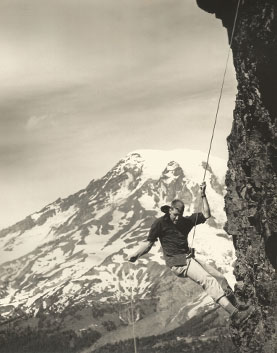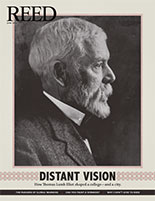
IRIS login | Reed College home Volume 93, No. 2: June 2014
Alumnus Profile
Gale Dick ’50
Canyon Sage
The Wasatch Mountains of Utah are a breathtaking example of geological majesty. Their rugged, unspoiled beauty is also, in its way, a testament to the work of environmental advocates like Gale Dick. One of the founders of Save Our Canyons, dedicated to protecting the beauty and wildness of the Wasatch, Gale was honored last year with the community service award from the Utah League of Women Voters. Commenting on the award, Salt Lake City mayor Ben McAdams called Gale a “community treasure” and “an intelligent, informed, and ethical advocate for the preservation of a precious natural asset.”
Gale’s passion for the outdoors goes back to his first year at Reed and an orientation backpack trip to Mount Jefferson. “I remember coming over the ridge, going down into that glorious valley, and just having this intense rush of just ecstatic happiness, because I knew I had four more years.” Reed cast the longest shadow of almost any experience in his life, he told Cricket Paramalee ’67 in 2007.
After earning a BA in physics at Reed, Gale studied mathematics at Oxford on a Rhodes scholarship. From there, he earned a PhD in physics at Cornell, where his interest in environmental preservation found its footing.
Gale and his wife, Ann Volkmann Dick ’50, arrived in Salt Lake City in 1959, when he began his career in the physics department at the University of Utah. Gale and Ann explored the map of Utah, skiing, hiking, backpacking, climbing mountains, and running rivers. In 1972, Gale helped found Save Our Canyons, which played a key role in establishing the Lone Peak Wilderness and protecting the Wasatch from development.
As the founders of Save Our Canyons age and retire, Gale is heartened to report that a younger cadre of activists is taking over the mission. “They are much better prepared and aware of the ways to effect change than were the founders,” he says.
Gale says the organization’s success reflects the fact that a majority of local residents share its ideals. “Here’s the recipe for keeping the Wasatch wild and beautiful,” he says. “Gather a group of people who want to do this, listen to their ideas, learn the facts, and meet with those who will make the decisions. Give this group tools to further their dreams. Push for protective policies.” And finally, “have the patience to pursue long-term goals.”


LATEST COMMENTS
steve-jobs-1976 I knew Steve Jobs when he was on the second floor of Quincy. (Fall...
Utnapishtim - 2 weeks ago
Prof. Mason Drukman [political science 1964–70] This is gold, pure gold. God bless, Prof. Drukman.
puredog - 1 month ago
virginia-davis-1965 Such a good friend & compatriot in the day of Satyricon...
czarchasm - 4 months ago
John Peara Baba 1990 John died of a broken heart from losing his mom and then his...
kodachrome - 7 months ago
Carol Sawyer 1962 Who wrote this obit? I'm writing something about Carol Sawyer...
MsLaurie Pepper - 8 months ago
William W. Wissman MAT 1969 ...and THREE sisters. Sabra, the oldest, Mary, the middle, and...
riclf - 10 months ago